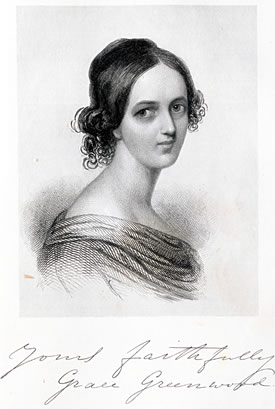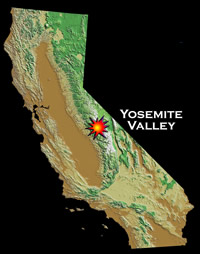From Eight Days in the Yosemite
Grace Greenwood
New York Times, July 27, 1872
 Born Sarah Jane Clarke in New York in 1823, she adopted the pseudonym “Grace Greenwood” both in print and in her personal life. Greenwood contributed to many of the prominent journals of her day, but her positions on contemporary social and political issues often rankled her publishers. Taking uncompromising stances on the need for prison reform, abolition of capital punishment, women’s rights, and against war and slavery, Greenwood became a popular writer and lecturer during the Civil War period. President Abraham Lincoln dubbed her “Grace Greenwood the Patriot,” for her fundraising efforts for the U.S. Sanitary Commission and for her frequent appearances before patriotic organizations and soldiers.
Born Sarah Jane Clarke in New York in 1823, she adopted the pseudonym “Grace Greenwood” both in print and in her personal life. Greenwood contributed to many of the prominent journals of her day, but her positions on contemporary social and political issues often rankled her publishers. Taking uncompromising stances on the need for prison reform, abolition of capital punishment, women’s rights, and against war and slavery, Greenwood became a popular writer and lecturer during the Civil War period. President Abraham Lincoln dubbed her “Grace Greenwood the Patriot,” for her fundraising efforts for the U.S. Sanitary Commission and for her frequent appearances before patriotic organizations and soldiers.
By the 1870s, Grace Greenwood wrote primarily for the New York Times. Many of her articles were travel pieces commenting on the wonders and uncertainties of the American West. On July 27, 1872, the New York Times published Greenwood’s “Eight Days in the Yosemite,” an account of her adventures in the valley.
In this account, Grace Greenwood finds the Yosemite Valley both vaguely oppressive and exhilarating. Greenwood’s description of John Muir may be the first reference to the famous naturalist in a national publication.
Yosemite Falls
 The Yosemite Falls [is] …on the north side of the valley. Of course, from below you can see nothing of the Yosemite Creek. It looks as though it was a cataract from the start, born of the sky and the precipice. The roar of this king of the water-falls, in his grandest times, has a singular dual character—there is the eternal monotone, always distinct, though broken in upon by the irregular crash and boom—a sort of gusty thunder. This composite sound, so changing and unchanging, floods and shakes the air, like the roar of the deep sea and the breaking of surf on a rocky shore.
The Yosemite Falls [is] …on the north side of the valley. Of course, from below you can see nothing of the Yosemite Creek. It looks as though it was a cataract from the start, born of the sky and the precipice. The roar of this king of the water-falls, in his grandest times, has a singular dual character—there is the eternal monotone, always distinct, though broken in upon by the irregular crash and boom—a sort of gusty thunder. This composite sound, so changing and unchanging, floods and shakes the air, like the roar of the deep sea and the breaking of surf on a rocky shore.
On my first night in the valley the strangeness of my surroundings, a sort of sombre delight that took possession of me, would not let me sleep for several hours. Once I rose and looked out, or tried to look out. The sky was clouded—it seemed to me that the stars drew back from the abyss. It was filled with night and sound. I could not see the mighty rocks that walled us in, but a sense of their shadow was upon me. There was in the awe I felt no element of real dread or fear, but it was thrilled by fantastic terrors. I thought of [Josiah] Whitney’s theory of the formation of the great pit, by subsidence. What if it should take another start in the night, and settle a mile or to with us, leaving the rail by which we descended dangling in the air, and the cataracts all spouting away, with no outlet! But in the morning the jolly sun peered down upon us, laughing, as much to say, “There you are, are you?” and the sweet, cool winds dipped down from the pines and the snows, the great fall shouted and danced all the way down his stupendous rocky stairway—the river, and overflowed meadows rippled and flashed with immortal glee. It seems to me that darkness is darker and light lighter in the Yosemite than anywhere else on earth.
Nature's Not Done Yet

Yet, in the midst of its utmost brightness and beauty you are more or less oppressed with a realization of some sudden convulsion of nature that here rent the rocks asunder, that shook the massive mountain till it shook the bottom out; or of the mighty force of drifting, driving glaciers, grinding, carving, just plowing down from the “High Sierra,” leaving the stupendous furrow behind them. Somehow you feel that nature has not done with the place yet. Such a grand, abandoned workshop invites her to return. The stage of this great, tragic theatre of the elements waits, perhaps, for some terrible afterpiece….
There is here at first a haunting sense of imprisonment, though on a grand scale, of course. You feel like a magnificent felon, incarcerated in the very fortress of the gods….
I found it impossible to work here, or even, to talk fluently or forcibly on what I knew about the Yosemite….I noticed that there were few singing-birds about, and was told by an old guide that they, with most animals, were afraid of the valley. Poetic thoughts and gay fancies seem struck with a like fear. You are for a time mentally unnerved; but you feel that in your powerlessness, you are gaining power; in your silence, more abundant expression.
A Young Visitor, Mr. Muir
Among our visitors in the evening was Mr. Muir, the young Scottish mountaineer, student, and enthusiast, who has taken sanctuary in the Yosemite—who stays by the variable valley with remarkable constancy—who adores her alike in the fast, gay Summer life and solemn Autumn glories, in her Winter cold and stillness, and in the passion of her Spring floods and tempests. Not profoundest snows can chill his ardor, not earthquakes can shake his allegiance. Mr. Muir talks with a quiet, quaint humor, and a simple eloquence which are quite delightful. He has a clear, blue eye, a firm, free step and marvelous nerve and endurance. He has the serious air and unconventional ways of a man who has been much with nature in her grand, solitary places. That tourist is fortunate who can have John Muir for a guide in and about the valley….

The Bridal Vail is my favorite Yosemite cataract. There is for me a tender, retrospective charm to the name. Just opposite to the Bridal Vail is the lovely little trickling cascade, called the Virgin’s Tears. Had the sight of the floating, flouting Vail anything to do with that lachrymose condition? We, who reached the Vail, lingered about it for hours—read and slept, botanized, and shouted poetry in each other’s ears. When the rainbows came, we went far up into the very heart of the splendor. We could have jumped through the radiant hoops like circus-performers….
Glacier Point
Glacier Point is on the south side of the valley, 3,700 feet above the meadows. It is the point that gives you the finest comprehensive view of the valley—especially of its upper waterfalls, cañons, and rocks—with vast views of the High Sierra. All the great heights were pointed out to us – Mount Hoffman, Mount Lyell, Mount Dana, Mount Clark, and Mount Starr King….
The vast view from Glacier Point is the despair of poetry and art. Certainly its grandeur can never be compassed by the grandest sweep of human language. Its divine loveliness floats forever before the mind—in smiling, radiant defiance. It is glory that must be seen; it is sublimity that must be felt; it is the “exceeding great reward” that must be toiled for.
